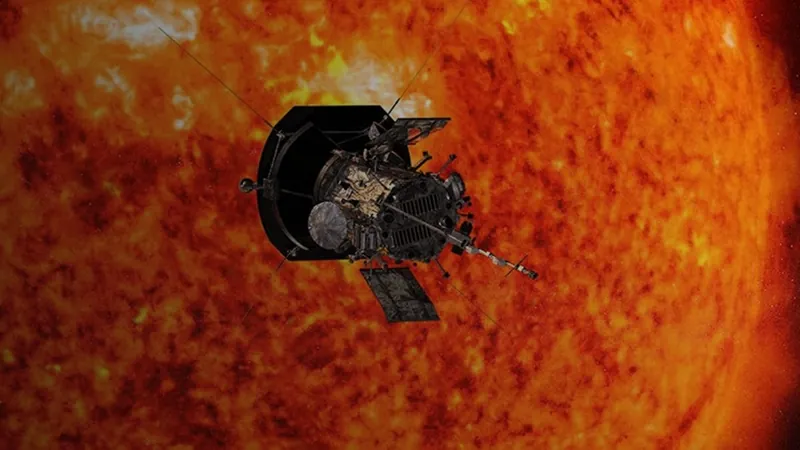
Unveiling the Mystery: How Did Supermassive Black Holes Evolve So Rapidly? The Role of Jets
2024-12-23
Author: Noah
Did you know that hiding in almost every galaxy is a supermassive black hole, a colossal entity that can weigh millions to even billions of times more than our Sun? The mystery of their rapid growth has baffled astronomers for years, especially in the light of observations from the groundbreaking James Webb Space Telescope (JWST). These cosmic powerhouses seem to have achieved their massive sizes in less time than previously thought—so what’s the secret behind their growth?
Traditionally, scientists believed that supermassive black holes increased their mass gradually over billions of years. However, the latest discoveries indicate that even the youngest galaxies house these giants. So how did these black holes manage to grow so quickly? Enter the powerful jets produced by black holes, which could be the answer we've been searching for.
At first glance, it might seem illogical that black holes have a hard time consuming surrounding matter. Despite their immense gravitational pull, the matter typically remains trapped in orbit rather than plunging straight in. In order for material to enter a black hole, it has to slow down enough to overcome the gravitational forces holding it in place. This is where the jets come into play. When a black hole emits a jet of high-speed plasma from its poles, it can dramatically influence the motion of nearby matter, effectively pulling it inward and facilitating the black hole's growth. Thus, black holes with robust jets tend to experience explosive growth.
Astrophysicists observe many rapidly growing black holes in the form of quasars—active galactic nuclei that are brilliant and energetic. This evidence signifies that during the mid-phase of the universe, supermassive black holes were accumulating mass at a dizzying pace. A prevailing hypothesis is that even the youngest supermassive black holes possessed active jets, allowing them to amass over a million solar masses within a surprisingly brief period.
But here lies the challenge: detecting jets from such an early epoch in the universe is notoriously difficult. The light emitted during that time gets redshifted, fading into dim radio frequencies. Prior to the latest research, the most distant jet observed had a redshift of z = 6.1, corresponding to light that has journeyed roughly 12.8 billion years to reach us. In a groundbreaking new study, a team has identified a blazar—a type of blazar is an extremely luminous active galactic nucleus—with a redshift of z = 7.0, originating from a mere 750 million years after the Big Bang.
What exactly is a blazar? It’s a phenomenon that occurs when the jet of a supermassive black hole is pointed almost directly toward Earth. This alignment allows astronomers to witness the jet at its most powerful intensity, making blazars essential for calculating the jet's true energy. However, the extreme redshift in this case complicates the interpretation of energy output.
One intriguing possibility is that this particular black hole's jet is indeed aimed right at us, suggesting it could grow by over a million solar masses in its formative years. Still, such precise alignment is incredibly rare. Statistically, this observation hints that many more early black holes are likely as active and growing as quickly; we just aren’t able to observe them due to unfavorable angles.
Another theory posits that the blazar’s energy may be magnified due to the cosmic expansion of space over the last 12.9 billion years. This distorts our perception, making the jet appear more energetic than it is. Should this be the case, it still implies that a significant number of early black holes boast powerful jets.
So what does this all mean? The research suggests either a select few early black holes experienced rapid growth or that most black holes gained mass swiftly, even earlier than previous observations indicated. In either scenario, one thing is clear: these early cosmic giants harnessed the power of jets, paving the way for the formation of supermassive black holes in the nascent universe.
As we unravel this cosmic conundrum, one question looms: How many supermassive black holes, yet to be discovered, are lurking in the dark corners of the universe, waiting to reveal their secrets? The universe is full of surprises, and the story of black holes is just beginning.









 Brasil (PT)
Brasil (PT)
 Canada (EN)
Canada (EN)
 Chile (ES)
Chile (ES)
 España (ES)
España (ES)
 France (FR)
France (FR)
 Hong Kong (EN)
Hong Kong (EN)
 Italia (IT)
Italia (IT)
 日本 (JA)
日本 (JA)
 Magyarország (HU)
Magyarország (HU)
 Norge (NO)
Norge (NO)
 Polska (PL)
Polska (PL)
 Schweiz (DE)
Schweiz (DE)
 Singapore (EN)
Singapore (EN)
 Sverige (SV)
Sverige (SV)
 Suomi (FI)
Suomi (FI)
 Türkiye (TR)
Türkiye (TR)